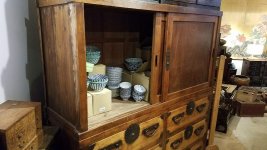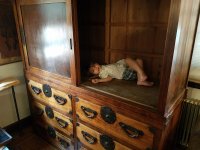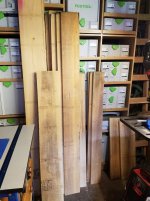ear3
Member
Anyone in the New York area with an interest in Japanese antiques and/or superb examples of Japanese carpentry and metalwork should know that Shibui and it's proprietor Dane Owen are pulling up stakes and moving to the West Coast:https://shibui.com/
The insanity of New York commercial space rents and add-ons have unfortunately gobbled up his margins, and so in preparation for the move he is unloading a lot of his current stock at incredible discounts rather than pay the cost of freighting it out West.
That turned out to be a great thing for me and especially my wife (whose enthusiasm for the Japanese stuff at times exceeds our budget), as it enabled us to afford a really impressive piece of furniture: a huge late 19th c. Meiji Era blanket/futon tansu (for scale, pics include one of my 2 year old nephew exploring the space once it arrived at our house).
[attachimg=1]
[attachimg=2]
[attachimg=3]
Total size is 67(l)x68(h)x23(d), made up of two stackable 34(h) units. The casing is made from Sugi and Hinoki wood, and the bookmatched panels from Keyaki wood.
This is now going to be my wife's main clothing storage space, and so to make it more efficient I'm going to build some interior shelving/storage for the top. I haven't decided yet precisely on the format, but since the sliding doors pop out easily, I was thinking of installing a separate, removable casing that could be a mixture of shelves and drawers. This way I won't have to drill into or attach anything to the original chest, and can simply pop out the casing if the unit ever gets repurposed for another use.
I'm wondering what people think about wood species for the add-on casing. I've tried in the past to track down Hinoki wood in the States without success, so there's no chance of staying within the current wood palette. My current thoughts are maybe Cypress (which I've never worked with before), or some sort of cedar, like Spanish or Port Orford Cedar (I've worked with and liked Spanish cedar, but have never even handled Port Orford cedar).
If I do add some drawers, I plan on going with some spare iron tansu handles that I also acquired from Shibui, and so keep my additions as authentic as possible.
I'm also excited that I now have on hand a good example of Japanese furniture construction that I can reference and copy from in the future in my own carpentry.
Anyway, any thoughts or suggestions would be appreciated.
The insanity of New York commercial space rents and add-ons have unfortunately gobbled up his margins, and so in preparation for the move he is unloading a lot of his current stock at incredible discounts rather than pay the cost of freighting it out West.
That turned out to be a great thing for me and especially my wife (whose enthusiasm for the Japanese stuff at times exceeds our budget), as it enabled us to afford a really impressive piece of furniture: a huge late 19th c. Meiji Era blanket/futon tansu (for scale, pics include one of my 2 year old nephew exploring the space once it arrived at our house).
[attachimg=1]
[attachimg=2]
[attachimg=3]
Total size is 67(l)x68(h)x23(d), made up of two stackable 34(h) units. The casing is made from Sugi and Hinoki wood, and the bookmatched panels from Keyaki wood.
This is now going to be my wife's main clothing storage space, and so to make it more efficient I'm going to build some interior shelving/storage for the top. I haven't decided yet precisely on the format, but since the sliding doors pop out easily, I was thinking of installing a separate, removable casing that could be a mixture of shelves and drawers. This way I won't have to drill into or attach anything to the original chest, and can simply pop out the casing if the unit ever gets repurposed for another use.
I'm wondering what people think about wood species for the add-on casing. I've tried in the past to track down Hinoki wood in the States without success, so there's no chance of staying within the current wood palette. My current thoughts are maybe Cypress (which I've never worked with before), or some sort of cedar, like Spanish or Port Orford Cedar (I've worked with and liked Spanish cedar, but have never even handled Port Orford cedar).
If I do add some drawers, I plan on going with some spare iron tansu handles that I also acquired from Shibui, and so keep my additions as authentic as possible.
I'm also excited that I now have on hand a good example of Japanese furniture construction that I can reference and copy from in the future in my own carpentry.
Anyway, any thoughts or suggestions would be appreciated.





